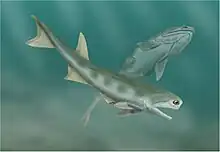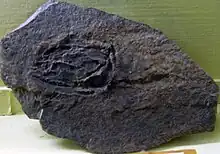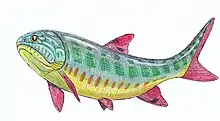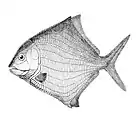Cheirolepis
Cheirolepis (from Greek: χείρ kheír, 'hand' and Greek: λεπίς lepis 'scale')[4] is an extinct genus of ray-finned fish that lived in the Devonian period of Europe and North America. It is the only genus yet known within the family Cheirolepidae and the order Cheirolepiformes. It was among the most basal of the Devonian actinopterygians and is considered the first to possess the "standard" dermal cranial bones seen in later actinopterygians.
| Cheirolepis Temporal range: | |
|---|---|
 | |
| Scientific classification | |
| Domain: | Eukaryota |
| Kingdom: | Animalia |
| Phylum: | Chordata |
| Class: | Actinopterygii |
| Subclass: | Chondrostei |
| Order: | †Cheirolepiformes Kazantzeva-Selezneva, 1977[1] |
| Family: | †Cheirolepidae Pander, 1860[2] |
| Genus: | †Cheirolepis Agassiz, 1835 |
| Type species | |
| †C. trailli Agassiz, 1835 | |
| Other species | |
| |
Cheirolepis was a predatory freshwater and estuarine animal about 55 centimetres (22 in) long. It had a streamlined body with small, triangular ganoid scales similar to those of the Acanthodii. These scales had a basic structure typical of many early osteichthyans, with a superficial of ganoine overlying dentine, and a basal plate of bone.[5] Cheirolepis had well-developed fins which gave it speed and stability, and was probably an active predator. Based on the size of its eyes, it hunted by sight. Cheirolepis's jaws, lined with sharp teeth, could be opened very wide, allowing it to swallow prey two thirds of its own size.[6]
Species

Six possible species of Cheirolepis are currently known. The type species, named in 1835, is C. trailli. Remains of this species have been found from Scotland and date back to the Eifelian and Givetian stages of the Middle Devonian. C. canadensis was described in 1881 from material found in Miguasha, Canada that dated back to the middle Frasnian stage of the Late Devonian. Two species, C. gracilis and C. gaugeri, have been found from Germany and Belarus in deposits that are of Givetian age. They were first described in 1973 from scale material that is now of questionable validity. Another species has been found from Belarus that lived during the Eifelian, and has been named C. sinualis. A new species has recently been described from a locality in Red Hill, Nevada deposited during the Mid-Late Devonian boundary. The specimen from which this species was named, consisting of scales and a lower jaw, was originally referred to C. canadensis. New, more complete specimens have shown it to be distinct from the type, although a species name is yet to be given for the remains.[7]

References
- Cheirolepiformes fossiilid.info (in Finnish)
- Cheirolepidae fossiilid.info (in Finnish)
- Arratia, Gloria & Cloutier, Richard: A new cheirolepidid fish from the Middle-Upper Devonian of Red Hill, Nevada, USA Archived 2017-03-15 at the Wayback Machine (PDF)
- Roberts, George (1839). An etymological and explanatory dictionary of the terms and language of geology. London: Longman, Orme, Brown, Green, & Longmans. p. 29. Retrieved 29 December 2021.
- Zylberberg, L.; Meunier, F. J.; Laurin, M. (2016). "A microanatomical and histological study of the postcranial dermal skeleton of the Devonian actinopterygian Cheirolepis canadensis". Acta Palaeontologica Polonica. 61 (2): 363–376. doi:10.4202/app.00161.2015.
- Palmer, D., ed. (1999). The Marshall Illustrated Encyclopedia of Dinosaurs and Prehistoric Animals. London: Marshall Editions. p. 34. ISBN 1-84028-152-9.
- Arratia, G. and Cloutier, R. (2004). A new cheirolepidid fish from the Middle-Upper Devonian of Red Hill, Nevada, USA. In: Arratia, G., Wilson, M. V. H. and Cloutier, B., eds., Recent Advances in the Origin and Early Radiation of Vertebrates. Verlag Dr. Friedrich Pfeil. München, Germany. pp. 583-598. ISBN 3-89937-052-X






